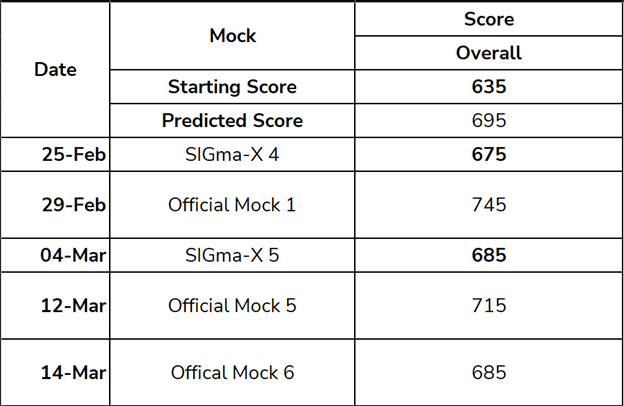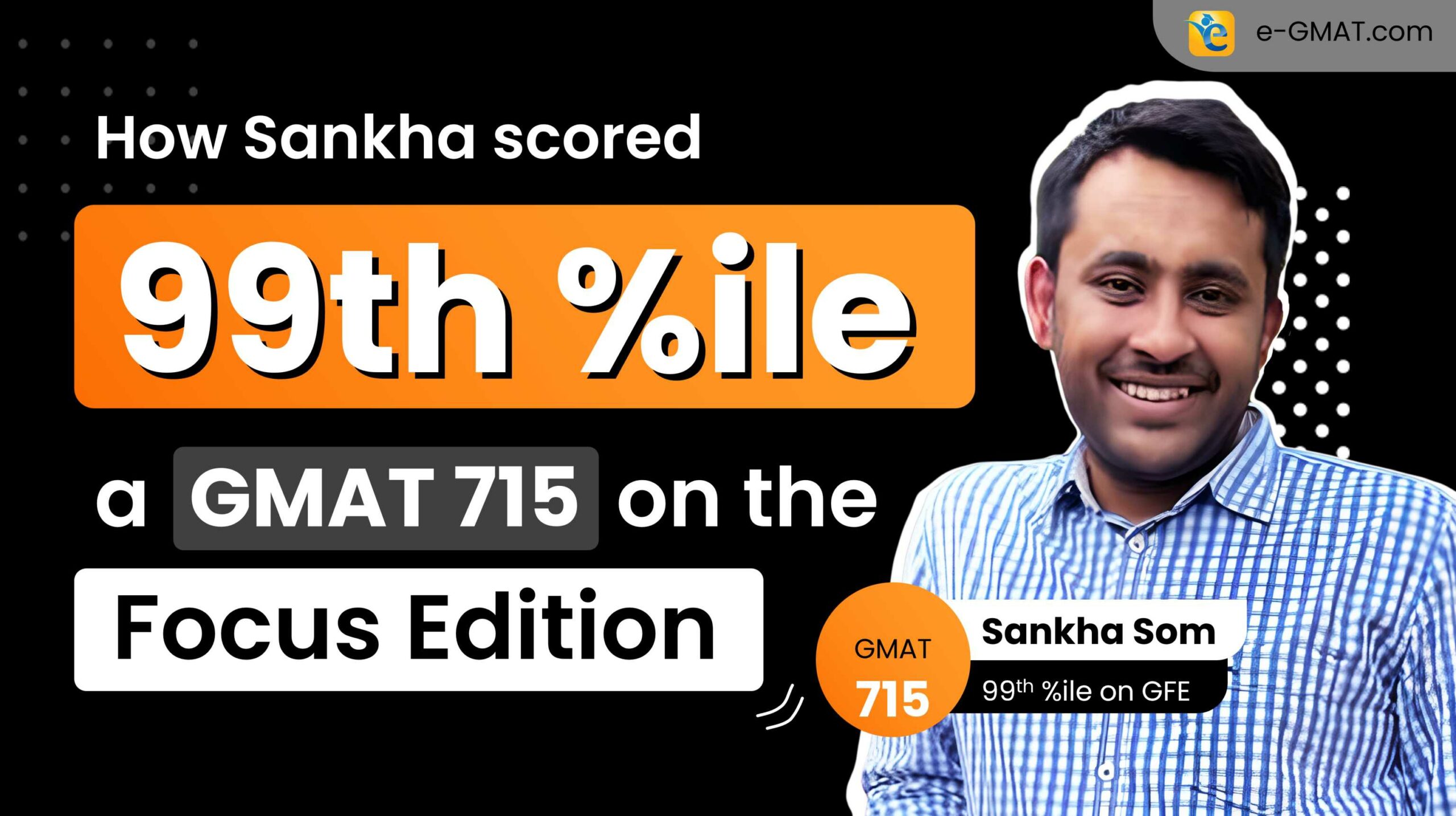Introduction
Achieving a top percentile score on the GMAT Focus Edition is a remarkable feat, reflecting not only mastery over the content but strategic acumen in navigating the test. Rahul’s journey to scoring 685, landing in the 97th percentile with scores of V82, D83, Q87, from a starting score of 635, showcases the blend of dedication, strategy, and insight required to excel. Through a detailed exploration of his preparation strategies, this narrative offers a roadmap for future aspirants aiming for GMAT success.
- Data Insights Excellence: Through focused preparation with e-GMAT’s DI course, Rahul improved from a D77, the 66th percentile, to a D83, an impressive 96th percentile!
- The Verbal Challenge: Verbal being his weakest area, Rahul faced difficulties in understanding question types and patterns. As a result, his accuracy in hard questions was below 50%. After improving his Pre-thinking and learning effective reading strategies, he was able to improve his overall accuracy in hard questions to over 70%. His accuracy in hard Boldface questions improved from a mere 18% to a commendable 71%, an impressive 90th percentile ability. (Charts included)
- The Quant Improvement: Quant being a strength, Rahul’s focus was on getting better at what he was already good at. Rahul delivered by increasing his accuracy in hard questions from as low as 55% in some subsections to as high as 85% in others, an incredible 98th percentile ability.
- Mock Exam Insights: e-GMAT’s SigmaX mocks provided Rahul with a realistic gauge of his test readiness and those were more reliable indicators of his score in his final exam, than Official Mocks!
- Last Mile Push Program: Working closely with his mentor Rashmi, Rahul was able to not only eliminate weaknesses in various sections of the exam, but also identify and work on behavioral issues that were impeding his performance towards GMAT success.
Outline
- The Verbal Challenge
- The Master Comprehension Course Benefit
- Excellence in Critical Reasoning
- Reading Comprehension Strategies
- Data Insights Excellence
- The Cementing Phase
- Strategic use of Scholaranium
- Mock Exam Insights
- Last Mile Push Program
The Verbal Challenge
Rahul’s biggest hurdle was to overcome the Verbal Section. His initial struggle with the verbal section was multifaceted, grappling with understanding question types and identifying patterns in questions, and lacking a structured approach to tackle them despite a previous 720 on the GCE. The following sections narrate his steps towards overcoming these hurdles and excelling.
The Master Comprehension Course Benefit
Doing e-GMAT‘s Master Comprehension course was a turning point for Rahul. Guided by his mentor Rashmi, he realized the foundational importance of mastering reading and comprehension skills, pivotal for critical reasoning, reading comprehension, and data insights sections. Master comprehension teaches you how to understand sentences in the least amount of time possible. After all, every second is precious in the exam. The pre-recorded sessions and exercises were very useful.
“This module teaches students how to read and comprehend sentences and passages the right way. This skill lies at the root of sections such as Critical Reasoning, Reading Comprehension, and even Data Insights.” (Rahul)
Excellence in Critical Reasoning
Rahul felt he had a relatively stronger foothold in CR, where he initially fared better. However, he lacked proficiency in inference and assumption questions, especially in hard questions. He overcame these weaknesses by adopting the pre-thinking method, markedly improving his CR accuracy, especially in bold face questions. In CR, Rahul started at a 50% accuracy in hard questions, but by the time he was done with the course, he was scoring 70% accuracy consistently in Hard level quizzes – an undeniable 90th percentile ability.

In Boldface questions, he went from an 18% accuracy to a 71% accuracy, making almost no mistakes in the last 20 questions or so, as shown below.

This brought his overall weighted accuracy in CR up 70%, as shown below:

“Everyone who solves CR does a certain amount of thinking. But what I liked the most at e-GMAT was the emphasis on pre-thinking before every single question and the step-by-step approach to pre-thinking correctly.” (Rahul)
Reading Comprehension Strategies
RC presented its set of challenges, which Rahul tackled by applying active reading strategies learned from the RC modules. Understanding patterns in question types and actively engaging with passages were key to his improvement.
“What I found most useful when I started the RC modules was that the patterns for every question type were right there – how should one be reading the passage, how to tackle a science passage, etc.” (Rahul)
After going through the modules, he was able to capture the essence of the author. According to Rahul, understanding the author’s view should enable anyone to answer about 70% of RC questions correctly. Rahul also worked on keeping tabs on what the author was NOT saying. His consistently high grades in the learning levels of his RC module stand testimony to his diligence in completing the RC course.

Overall, Rahul found the RC module very useful, especially because, as a working professional, he was always pressed for time. The Reading Comprehension module served all the important lessons on a platter, helping him utilize his time efficiently and effectively.

He was able to consistently score an average of 65% accuracy (80th to 85th percentile equivalent) in his last 10 hard level quizzes, as shown above; and this was across RC passages of all topics, as shown below.

Data Insights Excellence
Moving to the Data Insights section, Rahul demonstrated significant improvement, from D77 to D83, that is from a 66th percentile to a whopping 96th percentile. His trust in e-GMAT‘s structured preparation and practice, particularly the emphasis on understanding question templates, played a crucial role in his GMAT success.
“The DI questions were really new to me. In the course, every topic had a set of template questions, and these are the same template questions I saw in my final exam as well. The e-GMAT DI course wasn’t tons and tons of lectures for data insights. It was basically consists of standard template questions, with 5 sub-questions each. At the end of the five questions, you get a good idea of what they’re talking about. I was extremely happy with the e-GMAT DI course… it was just the e-GMAT DI module, and then the e-GMAT and OG mocks.” (Rahul)

Data Sufficiency was something Rahul was already good at, owing to his preparation for the GCE. However, the other subsections of the DI section posed a challenge. There was a dearth of study material available for the earlier IR section and its constituent question types. So, Rahul was particularly looking forward to the modules on Two-Part Analysis (TPA), Multi-Source Reasoning (MSR), etc. Rahul continued to apply himself and demonstrated high levels of diligence even during his DI course, as evidenced by the snapshot of the Journey View of his TPA module above.

Rahul’s MSR journey had a rough start, but he soon improved his understanding of the question templates and started to deliver, as seen by his gradually improving grades above.

The end-result was spectacular, and Rahul had laid the foundation that helped him get to a whopping 96th percentile ability score of D83 in his final exam. As seen in the image above, Rahul managed to cross the threshold of 55% accuracy (which translates to the 70% percentile ability) in hard quizzes across the board. In Graphs and Tables, he was able to muster a 70% accuracy (90th percentile ability), and in Data Sufficiency and MSR, he managed an incredible 80% accuracy (96th percentile ability).
The Cementing Phase
The cementing phase served as a critical confidence booster for Rahul, offering him a realistic simulation of the exam conditions and helping him to refine his skills under time pressure. This phase was instrumental in Rahul’s ability to identify and address any remaining weaknesses.
“Cementing was a major tool… It’s actually a really good method of learning because when I had prepared earlier without any guidance, I would just keep practicing questions blindly and I wasn’t sure where I was standing. Cementing and Rashmi’s guidance gave me direction.” (Rahul)
Cementing works like this – you give two quizzes of a certain difficulty level, medium or hard, and see whether you perform consistently above a certain threshold – 70% in medium and 55% in hard. And each quiz is a compilation of questions on all topics in that subsection. Passing cementing is your number one goal. And after you’ve done that it’s only behavioral issues you need to fix post that. Concept-wise, there’s nothing more to do. Cementing gives you not only direction to channelize your skills, but also the confidence that you’re genuinely good at something. It also helps clear misconceptions about areas you thought you were good at but aren’t really. That happened with Rahul in Critical Reasoning. It showed him that although he was good at medium level questions, he still needed to work on hard level questions.

“So, … with critical reasoning, … especially, at medium level, I was really great, but at hard, it showed I needed more preparation.” (Rahul)

It was this understanding of the cementing philosophy that propelled Rahul successfully past the cementing phase, subsection after subsection.
Strategic Use of Scholaranium
Rahul leveraged Scholaranium extensively, especially for its challenging questions and detailed data analytics. This tool helped him pinpoint areas for improvement, offering a realistic gauge of his preparedness for the exam.

Although he solved around 1600 questions on the e-GMAT platform, Rahul suggests not to go by numbers. He recommends that students take every single question seriously.
“The thing with Scholaranium questions is that every single question teaches and reinforces a Framework for solving questions, especially in DI.” (Rahul)
According to Rahul, when you’re preparing for the GMAT, it’s tough to find questions that are of the GMAT level and of the GMAT style. You can find many ‘math’ questions, but they won’t have the essence of a GMAT style quant question. And for Verbal, impossible! You cannot just search online and expect to find reliable GMAT style questions. You might think that they are in the same pattern, but they might turn out not to be. And you might be practicing well, but in the wrong direction.
“You might be practicing really well, but in the wrong direction. Scholaranium gives you a good sense of what the final exam is going to be like.” (Rahul)
Moreover, Rahul found the questions on Scholaranium much harder than the ones on the official mocks. In Rahul’s words, the Scholaranium is not so “tolerant” (or forgiving) as the GMAT official mocks. And that’s required because it helped him train at a harder level.
“I think the tolerance (for mistakes) you get from Official Mocks was much higher than the tolerance you get from the quizzes on Scholaranium.” (Rahul)
In fact, Rahul’s final score is closer to his performance in the Scholaranium quizzes and e-GMAT SigmaX mocks than to his performance in the official mocks. His official mock scores were always much higher than his final score.

Here’s a look at our DI Scholaranium launched recently.
Mock Exam Insights
Rahul’s strategic approach to mock exams, particularly the SigmaX mocks, provided him with a reliable estimate of his performance, thanks to their challenging nature and detailed analytics post-exam.

“SigmaX mocks were definitely tougher than official GMAT mocks, however, that’s a good thing because they gave the right picture!” (Rahul)
What Rahul liked even more was the level of data analysis provided after each mock, especially down to the question level analysis. Seeing how many people attempted and got the question right, what percentile of the test taking population selected which answer choice, what was the median time for solving, and much more.


“The Official Mocks are definitely the “gold standard”, however the level of post-test analysis of the SigmaX mocks was the key feature for me.” (Rahul)
Rahul particularly recalls the level of analysis Rashmi, his mentor, used to provide him on his mock attempts. She would dive deep into each mock attempt, and many of her discoveries pointed to behavioral issues that led to Rahul’s mistakes. Rashmi would point out the areas that Rahul was lacking in or needed to work on to get to this target scores. Rahul found that guidance really helpful and worked hard to not repeat those mistakes! The SigmaX Mocks capture the essence of the actual GMAT. They give you a good idea of what the final exam is actually going to be like. For a sneak peek at how we analyze official mocks at e-GMAT, join Rajat as he presents his analysis of the official mock of a student who scored a 645, and recommends a plan for at least of 50-point improvement in score.

Last Mile Push Program
The Last Mile Push Program was pivotal in Rahul’s final preparation stages, where hyper-specific, personalized improvement plans crafted by his mentor Rashmi played a crucial role in addressing his specific needs and bolstering his confidence for the exam. Rahul believes that everyone faces a time crunch during GMAT prep, sooner or later, as he did. It was really nice to have someone as a mentor who understood those pressures and helped alleviate them by offering timely and useful guidance. We were making use of most of the work already done and ensured we didn’t start from scratch. Rashmi would create improvement plans that capitalized on his strengths and worked toward making surgical improvements. Rahul recalls that, thanks to Rashmi, he didn’t not have the stress of worrying about what he needed to study or when.
“I blindly followed what Rashmi said – no regrets at all.” (Rahul)
Another crucial contribution of the Last Mile Push program was the guidance Rahul received in terms of tackling common behavioral issues that were impeding his performance. He had the tendency to lose focus. At times, he was over analyzing answers. For instance, if he felt a question to be too easy, instead of believing in his ability to solve it, he would double-guess himself and go with the wrong answer choice. Then there were times when he was anxious about the test, and this led him to making mistakes. On other occasions, he would guess the direction in which the test was going based on his perception of the difficulty level of the test, and that would cause him to panic. Most, if not all, students face these issues during the final leg of their preparation. Having a mentor experienced in handling such challenges can make all the difference to one’s prep.
Conclusion
Rahul’s journey to achieving a 685 on the GMAT Focus Edition is a testament to the effectiveness of targeted preparation, strategic practice, and personalized guidance. Through his dedication and strategic approach to overcoming challenges, particularly in the verbal section, Rahul not only achieved his goal score but also laid down a blueprint for GMAT success that future aspirants can follow.















